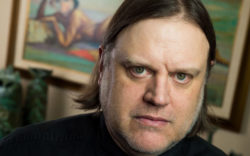Editor’s note: In the summer series Classic City Deadheads, Athenians are celebrating their love of the Grateful Dead and reflecting on some of their favorite Dead (or Dead-inspired) recordings. This week’s head is Eric Shea, a writer and musician who recently relocated to Athens from his home state of California.
As a teenage skate punk growing up in 1980s Northern California, my young cohorts and I were taught by the older guys that the Grateful Dead was the enemy. I once witnessed a friendly and disheveled looking fellow getting told to “beat it” upon arriving to a backyard ramp for wearing the band’s iconic Skull and Roses T-shirt.
Still, if you wanted to buy weed back in 1986, there was no better place to shop than the sprawling parking lot of a Dead show. My first Grateful Dead parking lot was overwhelming—we rolled up to what looked like a giant, psychedelic farmers market comprising a population of VW vans overflowing with tie-dye-clad longhairs, their unkempt children and dogs of all sizes and species.
Other than the omnipresent smell of patchouli, I couldn’t understand what those older skaters held against all this. The Deadheads had a thriving community. All we had was a scene. From my first visit to their community, it was evident that they looked out for each other. In our scene, we just criticized everyone for not being punk enough. Although I would go “shopping” in their parking lots throughout the late 1980s, I never once left the lot to see a show—a regret that I’ll take to the grave.
Fast forward to the mid 1990s. Jerry Garcia had already passed away. I moved to San Francisco to play music with a band called Mover. We started off inspired by the Rolling Stones and then by the Byrds, which led me down the Gram Parsons rabbit hole. I was so obsessed with the Flying Burrito Brothers that I began hosting Sleepless Nights, an annual live tribute to Parsons.
My roommate Jeremy was a Deadhead and turned me on to New Riders of the Purple Sage, a Bay Area country-rock band whose beginnings boasted Garcia on pedal steel. Jeremy handed me a cassette of his favorite Dead songs and said, “If you’re going to live in San Francisco, you’ve gotta make your peace with the Giants, Journey and the Dead.” I was thankful for the tape and relieved he didn’t say that I had to make my peace with Jefferson Starship.
I’ve since become a fan of the Grateful Dead. But to call myself a Deadhead would be insulting to those who actually followed this legendary band. Still, whenever I get homesick and I’m not in the mood for Dead Kennedys, I’ll always reach for the kaleidoscopic comforts of Aoxomoxoa.
Five Favorites
WORKINGMAN’S DEAD: Just as the Flying Burrito Brothers’ first album helped me fall in love with country music, Workingman’s Dead was my gateway to the Dead. When I DJed “Casey Jones” at Josh Schwartz’s (Beachwood Sparks, Painted Hills) wedding and saw Lou Barlow (Sebadoh, Dinosaur Jr.) dancing to it, I knew that I was doing alright.
AMERICAN BEAUTY: If you only have one Dead LP in your collection, make it this one. Every song is a gem. My favorite song changes regularly. Currently, it’s “Operator,” the only song that Pigpen got a songwriting credit for on a Grateful Dead studio album. But I’ll still play “Box of Rain” and dance around my bedroom like Lindsay Weir from “Freaks and Geeks.”
AOXOMOXOA: One of a handful of albums you can judge by its cover, Aoxomoxoa plays like a living, breathing, growing organism unto itself. NASA should have put “St. Stephen” on that golden Voyager record, because eventually the aliens are going to want to know what was so great about the Grateful Dead.
EUROPE ’72: Having never seen them live, Europe ’72 was my first live listening experience, and it contains my favorite version of “Morning Dew.” It was also Pigpen’s last stand, but getting Keith and Donna Jean Godchaux added to the lineup almost made up for losing him.
CORNELL 5/8/77: Any diehard Deadhead will tell you that “Betty Board” tapes—live recordings from an awesome soundboard owned and operated by Betty Cantor-Jackson—are the best quality. Most will also claim that this Cornell show is one of the top five examples of the Dead at its musical peak. That makes it a must-have for ardent fans as well as newcomers.
Like what you just read? Support Flagpole by making a donation today. Every dollar you give helps fund our ongoing mission to provide Athens with quality, independent journalism.








